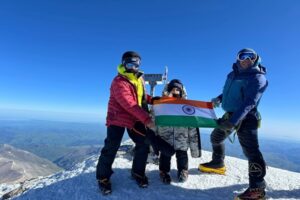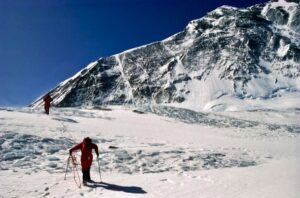The Icefall Doctors left Namche Bazaar today for Everest. They’re the Sherpas who fix and maintain the route through the hazardous Khumbu Icefall.
At Base Camp, they’ll find a bustling canvas town, with tents pitched and the Everest ER clinic already at work. Yet the commercial teams face confusion from new regulations established by the Khumbu authorities.
This year’s Icefall Doctors include Ang Sarki Sherpa, Dawa Nuru Sherpa, Pemba Tshering Sherpa, Ngima Tenzi Sherpa, Ngawang Chimmi Sherpa, Dawa Chirri Sherpa, Dawa Zangbu Sherpa, and Mingma Gyaljen Sherpa. Under the authority of the Sagarmatha Pollution Control Committee (SPCC), the group also has a Base Camp manager, two kitchen staff, and another in charge of garbage management.
Khumbu authorities, through the SPCC, want to improve waste management at Everest Base Camp this year. Among their new measures: All climbers must carry, use, and then return WAG bags to dispose of their human waste.

The 2024 Icefall Doctors pose in front of the Sagarmatha Pollution Control Committee in Namche Bazaar. Photo: SPCC
First, training
The work on the Icefall will not start until March 14. First, the team will stop for a week-long training course at the Khumbu Climbing Center in Portse. This year, Conrad Anker is one of the instructors.
The KCC was founded in 2003 by the Alex Lowe Charitable Foundation. It teaches climbing skills, mountain safety, rescue, wilderness first aid, and English every winter. While the first instructors were western climbers, the KCC now has expert local staff although an American, Pete Athans, still directs it. The chairman is Phunuru Sherpa.
Not enough yaks
By the time the Icefall Doctors reach Base Camp next week, the various commercial camps will be nearly ready. (The video below shows a drone’s-eye flyover of Elite Exped’s camp.) Everest ER, the Himalayan Rescue Association’s field clinic, is already staffed and working. The doctors attend to all kinds of medical emergencies. They charge foreign climbers for their services but offer free health care to locals.
It seems that Base Camp will be as big as in previous years. Yet the set of rules recently published by the Khumbu Pasang-Lamu municipality (in other words, by the Sherpa mayors of the Khumbu) are causing trouble to teams because of the huge loads of supplies they require.
Lukas Furtenbach told ExplorersWeb about delays in carrying equipment to Base Camp because not enough yaks are available. The new rules stated that helicopters transporting gear can only fly to Syangboche. The village lies at 4,000m, two days away from Base Camp. The last leg of the journey must take place on yak-back.
“However, there are not yaks enough for everyone,” Furtenbach said.
The main concern is not food or tents, but the innumerable cans of oxygen.
Apprehension
Outfitters are also apprehensive of other new regulations from Nepal’s Department of Tourism (DoT), soon to be published. The Everest season opens in one week, but there is no official news, just some reports about the obligation for climbers to carry what CNN first called “tracking chips.”
We are currently trying to confirm which device they are considering, including why such “chips” will make Everest safer. The DoT called them “GPS trackers” in their unofficial leaks, but other comments hint that they are probably thinking of simple radar reflectors.
The trackers are just one in a long list of issues that they discussed in a preliminary meeting on Feb 27. Whatever they decide, outfitters will hardly have time to make any major changes. However, if the devices they are considering are radar reflectors, these are already attached to many models of high-altitude clothing and most expedition boots.

List of topics discussed in a Feb. 27 meeting by Nepal expedition stakeholders. Note “Rescue Chip” on line 7. Photo: Mingma G
“We are used to last-minute, surprising rules,” Mingma G of Imagine Nepal admitted to ExplorersWeb. “I hope, one day, our government…will decide on practical rules at least a year ahead so that we get plenty of time to prepare accordingly.”
Rope-fixing 2024
Nepal’s Expedition Operators Association (EOA) has also just revealed the name of the outfitter in charge of fixing the ropes and managing the material and human resources between Camp 2 (6,400m) and the summit. According to Mingma G, the task is back to Seven Summit Treks.
The EOA makes its decision based on the bids of the local companies that apply for it. Only Everest, Manaslu, and Ama Dablam employ such a system. Everywhere else, including the 8,000’ers, rope-fixing and shared contributions are arranged more informally between the teams on the mountain.

Climbers on fixed ropes approach Camp 4 on Everest. Photo: Seven Summit Treks
The key question is whether the powerful Seven Summit Treks will use helicopters to carry the ropes to Camp 2, as they did in previous years, or whether the new regulations will restrict them. The Khumbu authorities have stated that helicopters are only allowed above Base Camp for rescues and emergency evacuations.
Mingma G’s Imagine Nepal was in charge of the job last year but suffered tragedy when three Sherpas died while carrying gear through the Icefall after a section collapsed.






